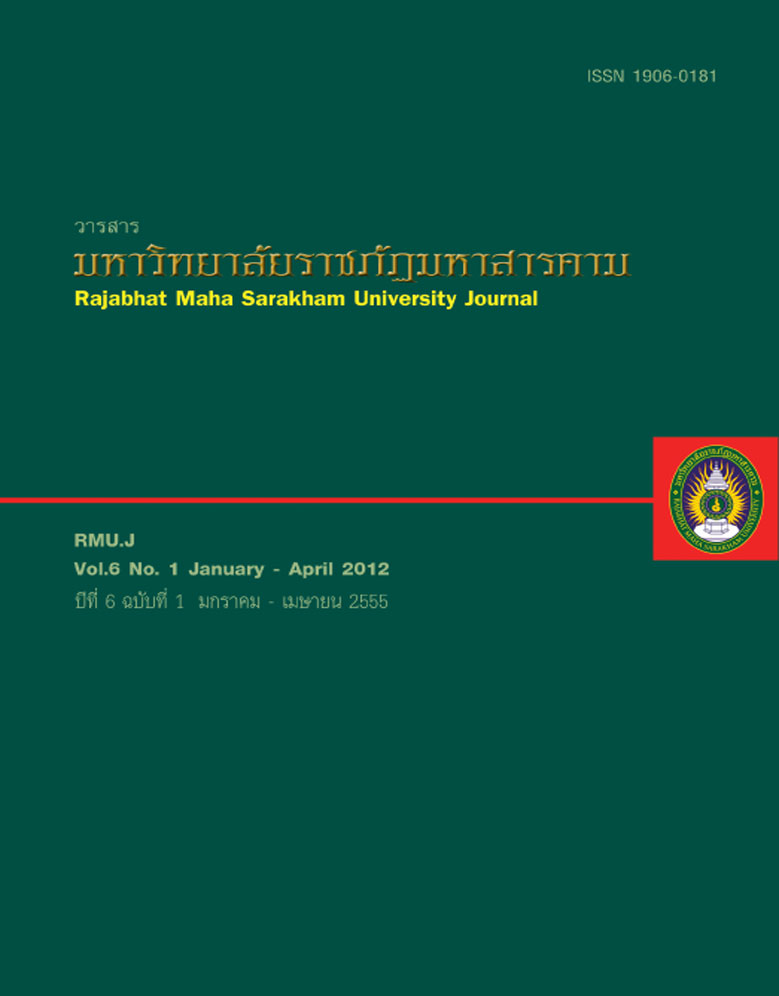การคัดกรองและให้ความช่วยเหลือนักเรียนที่มีภาวะเสี่ยงเป็นเด็กพิเศษระดับชั้นประถมศึกษา ของโรงเรียนเทศบาลศรีสวัสดิ์วิทยา;Assessment and Intervention Program for Grade 1st - 6th Students with At-Risks in Academic Failures at Thetsaban Srisawat School, Mahasar
Main Article Content
บทคัดย่อ
ในงานวิจัยก่อนหน้านี้คณะผู้วิจัยใช้แบบวัดระดับสติปัญญาที่เป็นมาตรฐานสากล CPM (Colored Progressive Matrices)
ในการสำรวจภาวะเสี่ยงเป็นเด็กพิเศษของนักเรียนระดับประถมศึกษาปีที่ 1-6 ที่ศึกษาอยู่ในโรงเรียนสังกัดเทศบาลเมืองมหาสารคาม
จำนวน 7 แห่ง พบว่าจากนักเรียนที่สุ่มมาศึกษา 1,047 คนมีผู้ที่อยู่ในภาวะเสี่ยงเป็นเด็กต้องการความช่วยเหลือพิเศษเพราะมีระดับ
IQ ตํ่ากว่า 90 อยู่ทั้งหมด 214 คน สำหรับงานวิจัยในครั้งนี้ คณะผู้วิจัยได้เลือกโรงเรียนเทศบาลศรีสวัสดิ์วิทยาซึ่งถูกระบุไว้ในงาน
วิจัยของคณะผู้วิจัยก่อนหน้านี้ว่ามีนักเรียนอยู่ในภาวะเสี่ยงเป็นเด็กต้องการความช่วยเหลือพิเศษจำนวน 30 คนเป็นสถานที่วิจัย ใน
การศึกษานี้ คณะผู้วิจัยมีจุดมุ่งหมายหลักอยู่ 3 ประการคือ 1) เพื่อจำแนกชนิดความพิเศษของนักเรียนที่มีภาวะเสี่ยงเป็นเด็กพิเศษ
จำนวน 30 คนโดยใช้แบบคัดกรอง KUS - SI Scales : ADHD/LD/Autism (PDDs) 2) พัฒนาศักยภาพการสอนของครูที่ต้อง
สื่อสารกับนักเรียนพิเศษ 3) จัดตั้งศูนย์พัฒนาการเรียนรู้ของนักเรียนเทศบาลศรีสวัสดิ์วิทยา ผลการวิจัยพบว่าจากนักเรียน 30 คน
มีเพียง 26 คนที่จัดว่าเป็นเด็กที่มีภาวะเสี่ยงเป็นเด็กพิเศษตามมาตรฐานของแบบคัดกรอง KUS - SI Scales พบว่ากลุ่มที่มีภาวะ
เสี่ยงเป็นเด็กพิเศษด้านออทิสซึม (Autism/ PDDS) มีจำนวน 10 คน กลุ่มที่มีภาวะเสี่ยงเป็นเด็กพิเศษด้านสมาธิสั้น (ADHD) มี
จำนวน 23 คนและกลุ่มที่มีภาวะเสี่ยงเป็นเด็กพิเศษด้านบกพร่องทางการเรียนรู้ (LD) มีจำนวน 25 คน คณะผู้วิจัยพบว่า เด็กนักเรียน
ส่วนใหญ่มีภาวะเสี่ยงเป็นเด็กพิเศษมากกว่า 1 ด้านในคนคนเดียวกัน เพื่อพัฒนาศักยภาพการสอนของครู คณะผู้วิจัยได้จัดอบรมครู
ที่เกี่ยวข้องกับนักเรียนทั้ง 3 กลุ่มนี้โดยให้ทำหลักสูตรเฉพาะรายบุคคล (Individual Education Plan : IEP) แผนการจัดการสอน
(Individual Implementation Plan : IIP) เพื่อนำไปใช้สอนในภาคการศึกษา1/ 2554 และจะมีการติดตามเพื่อประเมินผลและ
ปรับปรุงต่อไปในอนาคต ผลจากการศึกษานี้คณะผู้วิจัยได้นำไปใช้ในการพิจารณาจัดตั้งศูนย์พัฒนาการเรียนรู้ของนักเรียนโรงเรียน
เทศบาลศรีสวัสดิ์วิทยาจนแล้วเสร็จในปีการศึกษา 2553;
In the previous research, Colored Progressive Matrices (CPM) were applied to assess 1,047 (grade
1-6) students of 7 elementary schools under Muang Mahasarakham Municipal Office, and 214 of these
students were identified with their IQ level lower than 90, and thus defined as children with at-risks in
academic failures. This study focused on 30 students of Tessabarn Sri Sawat Wittaya School who had been
defined by the previous research as at-risk students, and aimed to 1) categorize these 30 students with atrisks
in academic failures into certain groups using KUS-SI rating scales Attention Deficit and Hyperactivity
Disorder (ADHD)/ Learning Disabilities (LD)/ Autism (PDDs), 2) enhance teaching potential of teachers
who communicate with these 30 students, 3) establish the learning development center at Tessabarn Sri
Sawat Wittaya School, which is one of the seven elementary schools affiliated with Muang Mahasarakham
Municipal Office. Results revealed the following: 26 of these 30 students were confirmed by using the
method of KUS-SI rating scales: ADHD/ LD/PDDs as being children with at-risks in academic failures.; 10
students were categorized as the PDDS group; 23 students were defined as the ADHD group; and 25
students were classified as the LD group. In most cases, it was found that most of these children were
diagnosed as having more than one type of academic failures. Regarding enhancement of teaching
potential, teachers of these at-risk children were trained in developing Individual Education Plans (IEP)
and using Individual Implementation Plans (IIP)for their special students, to be implemented in the first
semester of the 2011 academic year. There would be a follow-up assessment of these instructional plans
after actual implementation. Findings of this research were taken into consideration in establishing the
learning development center, which was finally set up at Tessabarn Sri Sawat Wittaya school in the 2011
academic year.
Article Details
1. บทความที่ลงตีพิมพ์ทุกเรื่องได้รับการตรวจทางวิชาการโดยผู้ประเมินอิสระ ผู้ทรงคุณวุฒิ (Peer Review) สาขาที่เกี่ยวข้อง อย่างน้อย 3 ท่าน ในรูปแบบ Double blind review
2. ข้อคิดเห็นใด ๆ ของบทความที่ลงตีพิมพ์ในวารสารมหาวิทยาลัยราชภัฏมหาสารคาม นี้เป็นของผู้เขียน คณะผู้จัดทำวารสารไม่จำเป็นต้องเห็นด้วย
3. กองบรรณาธิการวารสารมหาวิทยาลัยราชภัฏมหาสารคาม ไม่สงวนสิทธิ์การคัดลอกแต่ให้อ้างอิงแสดงที่มา


